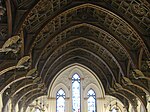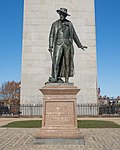Thompson Square station
Boston building and structure stubsCharlestown, BostonFormer MBTA stations in MassachusettsMassachusetts Bay Transportation Authority stubsMassachusetts railway station stubs ... and 2 more
Orange Line (MBTA) stationsRailway stations in Boston

Thompson Square was a rapid transit station in Charlestown, Massachusetts. It served the Charlestown Elevated, part of the MBTA's Orange Line, from 1902 until 1975.
Excerpt from the Wikipedia article Thompson Square station (License: CC BY-SA 3.0, Authors, Images).Thompson Square station
Main Street, Boston Charlestown
Geographical coordinates (GPS) Address Nearby Places Show on map
Geographical coordinates (GPS)
| Latitude | Longitude |
|---|---|
| N 42.375044444444 ° | E -71.064033333333 ° |
Address
Bluebikes
Main Street
02129 Boston, Charlestown
Massachusetts, United States
Open on Google Maps








